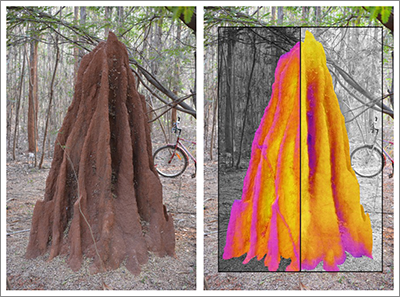(CAMBRIDGE, MA) – Sustainable architecture of the future could be inspired by new insights into how termites construct their climate-controlled habitats. Wyss Institute Core Faculty member L. Mahadevan, Ph.D., led the new study – reported this week in the Proceedings of the National Academy of Sciences – in which his team precisely measured the air flow inside a termite mound. They discovered that diurnal changes in the ambient temperature associated with the day-night cycle results in systemic ventilation inside the mound that flushes carbon dioxide out of the nest.

Mahadevan is also the Lola England de Valpine Professor of Applied Mathematics, Professor of Organismic and Evolutionary Biology and Professor of Physics at Harvard University.
Termites use swarm intelligence and collective behavior to construct mounds on top of their deep subterranean nests. The mounds protect them from the external environment while allowing the insects to exchange energy, information, and matter with the outside world. This controlled micro-climate is constructed by the termites to manage heat, humidity and respiratory gas exchange, providing an optimal environment to grow the brood and fungi, which maintain a symbiotic relationship inside the mound. The fungi produce sugars on which the termites feed.
But until now, scientists have lacked direct measurement of the internal air flows of a colony’s mound to understand exactly how the geometry of the structure allows it to maintain precise internal climate control.
To investigate, two members of Mahadevan’s team traveled to India to study the mounds of the termite species Odontotermes obesus. Hunter King, Ph.D., Postdoctoral fellow in Applied Mathematics at the Harvard Paulson School of Applied Science and Engineering (SEAS) and Sam Ocko, a graduate student in physics at the Massachusetts Institute of Technology, instrumented the mounds to make direct measurements of their internal temperature, air velocity and carbon dioxide.
The team’s observations show that thin, outer channels of the mound heat up rapidly during the day when compared to the deeper tunnels in the mound, which causes air to circulate in a closed-loop convection cell. During the day, air moves up along the outer channels and down the center. At night, the flow is reversed. This reversal flushes out the carbon dioxide from deep inside the mound, and the gas then diffuses through the porous walls.
"Thus, the termite mound works like a slowly breathing lung, flushing CO2 out once a day and aerating the mound," said Mahadevan.
The design of these mounds could inspire novel architectures that similarly would take advantage of diurnal thermal oscillations to ventilate buildings.
The work was supported by the Wyss Institute for Biologically Inspired Engineering at Harvard University and the Human Frontiers Science Program.